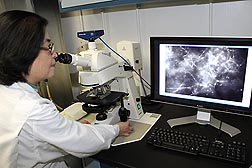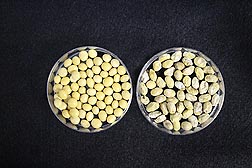Advance May Speed Development of Seed Rot-Resistant Soybeans
|
|
Soybeans have been called the “wonder crop” for all the products that can be made from the versatile legume—including cooking oil, tofu, livestock feed, and biodiesel, to name just a few. But America’s second-largest field crop next to corn is no match against Phomopsis longicolla, a seed rot fungus, which, along with other species, cost soybean producers in 16 southern states over 2 million bushels in losses in 2012.
Applying fungicides, rotating soybeans with nonhost crops, and tilling the soil are among strategies used by growers to prevent P. longicolla from causing Phomopsis seed decay (PSD), a disease which degrades the seed and reduces the quality of the protein and oil constituents. “Breeding for resistance to PSD is the most effective long-term strategy,” notes Shuxian Li, a plant pathologist in the Agricultural Research Service’s Crop Genetics Research Unit in Stoneville, Mississippi.
As part of a Phomopsis resistance program there, Li has sought to learn more about how the fungus inflicts harm at the cellular level. Towards that end, she and colleagues enlisted the aid of Agrobacterium tumefaciens, a soil bacterium commonly used in genetic engineering procedures to endow plants with new traits. In this instance, the team used the bacterium to “shuttle” genes for an antibiotic marker and green fluorescent protein (GFP) into the nuclei of the fungus’s cells. This resulted in new P. longicolla strains that produce the protein and emit a green glow when exposed to light in the blue-to-ultraviolet range.
|
|
“Green fluorescent protein is amazingly useful in scientific research, because it allows researchers to look directly into the inner workings of cells,” says Li, who collaborated with Burton Bluhm and others at the University of Arkansas in Fayetteville. “Using this transformation method, we can monitor how the fungus infects plants.”
The researchers compared the characteristics of seven GFP-modified strains to an unmodified “parent” isolate, and they confirmed the presence of the protein by using a molecular test method called “Southern blot analysis” and by direct observation with a confocal laser scanning microscope. A paper published in the March 2013 issue of the Journal of Microbiological Methods describes their research in detail.
Li plans on inoculating soybean seedlings with the modified strains to study how the infection process unfolds within the tissues of both resistant and susceptible soybean germplasm lines. She expects use of the GFP-expressing strains will also help to identify sources of PSD resistance that may escape detection using conventional disease-screening methods, such as field observation or visual assessment of seed on culture medium in the laboratory.
With the recent sequencing of P. longicolla’s entire genomic code, use of the transformed strains will allow researchers to probe the function of specific genes for virulence directly in soybean plants, potentially unlocking new clues to protecting this important crop. Use of the soybeans with GFP, however, will be limited to scientific research.—By Jan Suszkiw, Agricultural Research Service Information Staff.
This research is part of Plant Genetic Resources, Genomics, and Genetic Improvement (#301) and Plant Diseases (#303), two ARS national programs described at www.nps.ars.usda.gov.
Shuxian Li is in the USDA-ARS Crop Genetics Research Unit, 141 Experiment Station Rd., Stoneville, MS 38776; (662) 686-3061.
"Advance May Speed Development of Seed Rot-Resistant Soybeans" was published in the May/June 2014 issue of Agricultural Research magazine.








